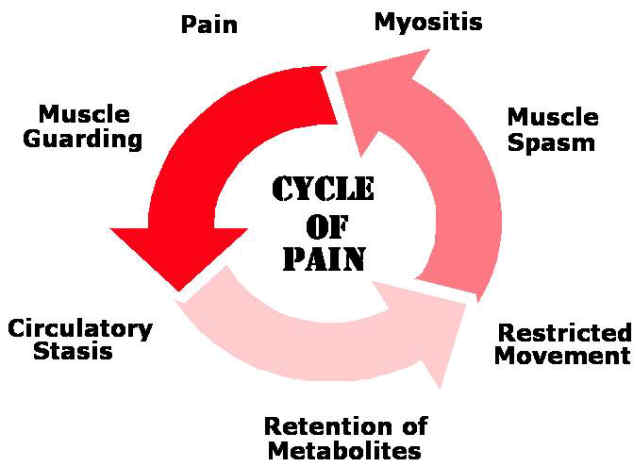An Overview of Pain
Pain is a protective sensory experience that alerts the mind-body of a trauma, injury, or illness. The body's response to injury and subsequent pain is swift and complex.
The Primary Pain Cycle
The primary pain cycle illustrates physiologic tissue responses during acute tissue injury and inflammation. Following a tissue injury, muscles maintain high levels of resting tension to protect healing tissue and prevent motion. Because muscles are continuously in order to guard the region, circulation to the affected muscle tissue decreases. This triggers a cycle of swelling, impaired circulation, inflammation, fatigue, and soreness.
Watch and listen to a description of this process:
 http://abwwc.com/images/Cycle%20of%20Pain%20-%203.jpg
http://abwwc.com/images/Cycle%20of%20Pain%20-%203.jpg
The "cardinal signs of inflammation" indicating tissue injury are often included in the patient subjective complaints following trauma.
- pain
- heat
- erythema ("redness")
- edema ("swelling")
- loss of function
The ascending and descending pathways for sensory and motor pathways are described in your text. The level of detail concerning lamina within the spinal cord and the subdivisions of the ascending and descending tracts are beyond the scope of this lecture.
"Take Home" Points
Sensory pain stimulus from the external or internal environments travel up the nerve and cross over to the contralateral side at the level of the spinal cord/brainstem
Ascending sensory tracts synapse in endocrine, motor, sensory, and limbic (emotional) and memory cortical areas, resulting in a complex response we call PAIN.
Inflammation is an essential component for tissue healing. Without inflammation, there would be no tissue repair.
Inflammation and its effects need to be addressed to optimize tissue healing and interrupt the pain cycle

